Home / Making Alkyl Halides From Alcohols
Alcohols, Epoxides and Ethers
Making Alkyl Halides From Alcohols
Last updated: July 3rd, 2025 |
Making Alkyl Halides From Alcohols
In today’s post we show that treating alcohols with HCl, HBr, or HI (which all fall under the catch-all term “HX” where X is a halide) results in the formation of alkyl halides.
- Primary alcohols tend to proceed through an SN2 mechanism
- Tertiary alcohols tend to proceed through an SN1 mechanism
- Watch out for rearrangements in reactions where a secondary carbocation may be formed
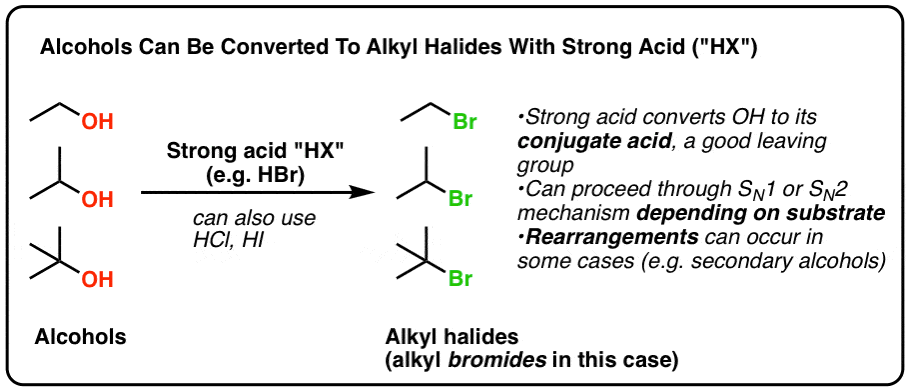
Table of Contents
- Adding Acid To Alcohol Produces A Good Leaving Group (H2O)
- Alkyl Halides From Methyl and Primary Alcohols via the SN2 Reaction
- Alkyl Halides From Tertiary Alcohols Proceeds Through The SN1 Pathway
- A Good Rule Of Thumb For Secondary Alcohols With HX: Assume SN1
- Rearrangements In The Formation of Alkyl Halides From Alcohols
- Rearrangement Example #1: Hydride Shift
- Rearrangement Example #2: Alkyl Shift
- Rearrangement Example #3: A Special Case of Alkyl Shift – Ring Expansion and Contraction
- What Doesn’t Work?
- Summary: Alkyl Halides From Alcohols
- Notes
- Quiz Yourself!
- (Advanced) References and Further Reading
1. Adding Acid To Alcohol Results In A Good Leaving Group
We’ve said many times in this series of posts that alcohols are poor substrates for SN1 and SN2 reactions. That’s because the hydroxyl ion (HO-) is a poor leaving group, and therefore not likely to either 1) depart of its own accord, leaving behind a carbocation (SN1 pathway) or 2) to be displaced by an incoming nucleophile (which would be an SN2 reaction).
However we’ve also seen that treating an alcohol with acid leads to an interesting “personality adjustment”: the alcohol (R-OH) is converted to its conjugate acid, (R-OH2+) which now possesses a decent leaving group (the weak base we know as water, H2O). (See post: How to Make Alcohols More Reactive)
We saw, in a previous post, how this allows for formation of (symmetrical) ethers from alcohols, either via SN2 pathway (with primary alcohols) or an SN1 pathway (tertiary alcohols).
We might ask: can this be extended to form other functional groups besides ethers?
Absolutely. Treating alcohols with HCl, HBr, or HI (which all fall under the catch-all term “HX” where X is a halide) results in the formation of alkyl halides.
This occurs in a two step process:
- first, the alcohol is protonated to give its conjugate acid.
- Secondly, a substitution occurs.
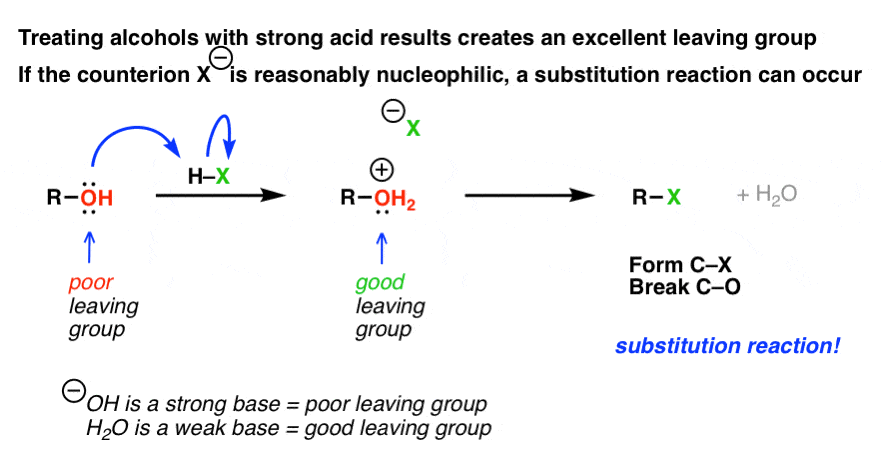
Notice how that second step (substitution) was left vague in the diagram above. That’s because, as we’ve seen, the type of substitution pathway depends on the substrate.
2. Alkyl Halides From Methyl And Primary Alcohols Via SN2 Reaction
Knowing how sensitive the SN2 reaction is to steric hindrance, we should expect that for methyl alcohol and for primary alcohols, the SN2 pathway dominates. And it does! (See post: The SN2 Mechanism)
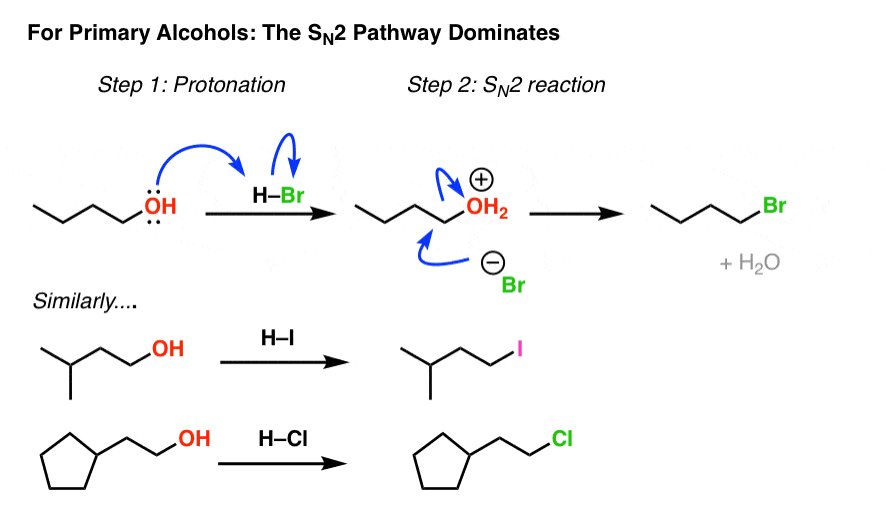
Note how in each case we begin by protonating the alcohol, creating a good leaving group which is then displaced by the conjugate base of the acid. (See post: What Makes a Good Leaving Group?)
Alkyl chlorides, bromides, and iodides can each be made this way.
3. Alkyl Halides From Tertiary Alcohols Proceeds Through The SN1 Pathway
Likewise, understanding the trends of carbocation stability, we should expect that conversion of tertiary alcohols to alkyl halides proceeds through an SN1 pathway. And it does. (See post: The SN1 Mechanism)

Note in the last example that beginning with a chiral starting material will lead to a mixture of inversion and retention (often called, “racemization“) because it goes through the (flat) intermediate carbocation.
4. A Good Rule of Thumb For Secondary Alcohols With HX: Assume SN1
Methyl, primary, and tertiary alcohols all represent pretty straightforward cases.
“So what about secondary alcohols?” you might ask. Ah yes. This is where things get interesting – and is, therefore, the stuff of which exam questions are made.
In the lab, treatment of secondary alcohols with HX leads to a mixture of products from SN1 and SN2 pathways. For practical purposes it is generally not a useful process, especially if you care about preserving stereochemistry.
However, your introductory textbook and course notes are not “the lab”. The purpose of a course is to introduce you to important concepts in organic chemistry. And from an instructor’s standpoint, it so happens that the conversion of secondary alcohols to secondary alkyl halides by HX is an excellent opportunity to bring up the subject of carbocation rearrangements. This falls under the purview of the SN1 pathway.
So a good rule of thumb is to assume – for the purposes of your course – that secondary alcohols treated with HX will proceed through an SN1 mechanism.
5. Rearrangements In The Formation Of Alkyl Halides From Alcohols
We’ve covered rearrangements (hydride and alkyl shifts) before in the context of SN1 reactions. But it’s worth touching on again.
The basic premise is this. Carbocations are unstable, electron-poor species. Their stability generally increases with the number of attached carbons, which serve to donate electron density. Hence, the stability of carbocations increases in the direction methyl < primary < secondary < tertiary. We also saw that carbocations are stabilized by resonance.
As we saw in a previous series of posts – consult this if you need more hand holding! – carbocations can undergo 1,2 shifts of C-H and C-C bonds, resulting in new carbocations.
Such rearrangements are most likely to occur if they can result in a more stable carbocation. For example, the rearrangement of a secondary to a tertiary carbocation, is a favoured (energetically “downhill”) process, whereas a rearrangement from a tertiary to a secondary carbocation (energetically “uphill”) is unlikely.
Anytime a reaction proceeds through a carbocation intermediate, we need to be on the lookout to see if it is adjacent to a carbon which can generate a more stable carbocation through a shift of a C-H or C-C bond.
There are three cases in particular to watch out for.
6. Rearrangement Example #1: A Hydride shift
Look for a secondary alcohol adjacent to a tertiary carbon. Note this common example, where protonation leads to loss of water, followed by a hydride shift and then trapping of the carbocation by the halide ion.
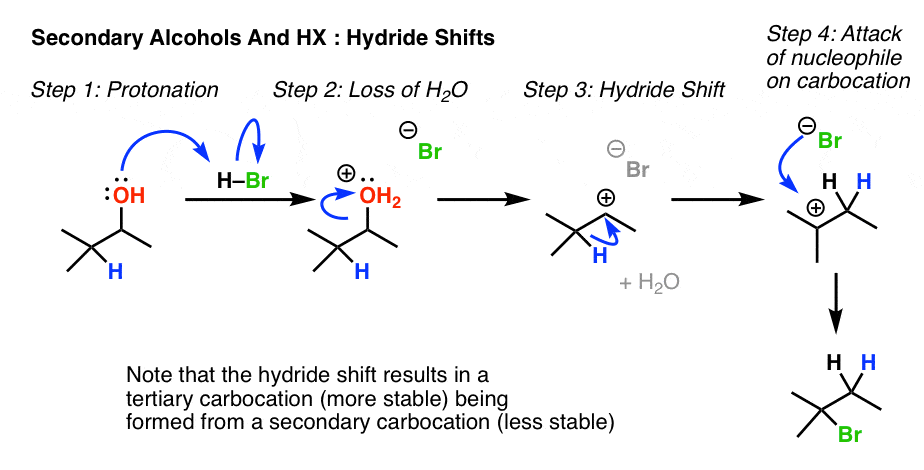
Another example of a favourable rearrangement is when a secondary carbocation is adjacent to an “allylic” or “benzylic” hydrogen. Rearrangement results in a secondary carbon which is stabilized by resonance.

7. Rearrangement Example #2: Alkyl Shift
Look for a secondary alcohol adjacent to a quaternary carbon (i.e. a carbon attached to 4 other carbons). Note how this is essentially the exact same process as the hydride shift above, except that CH3 is migrating, not H.

8. Rearrangement Example #3: A Special Case of Alkyl Shifts – Ring Expansions And Contractions
Look for a secondary alcohol that is adjacent to a strained ring (cyclobutane in the classic case). Once the secondary carbocation is generated, a bond in the strained ring migrates, leading to expansion of the ring by one. This is particularly favourable in the case of cyclobutane to cyclopentane since cyclobutane is highly strained (about 26 kcal/mol) whereas cyclopentane has minimal ring strain.
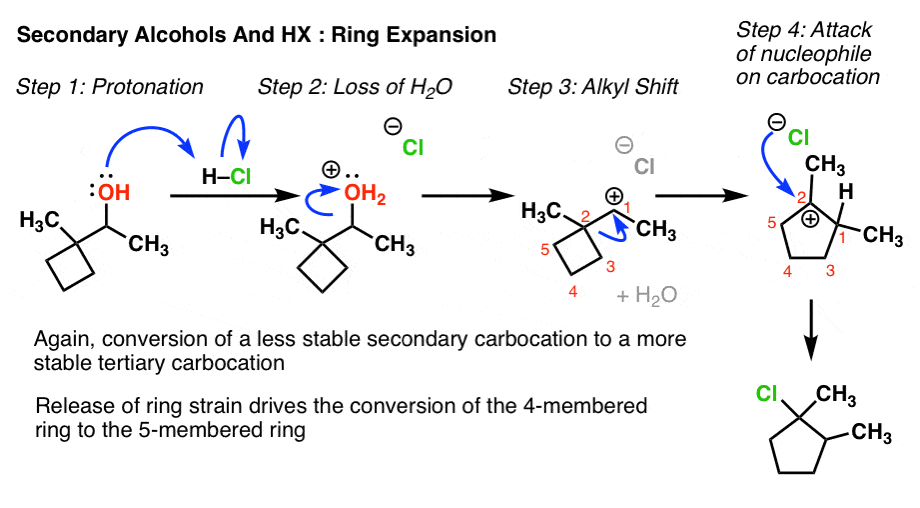
This type of alkyl shift commonly gives students a hard time, which of course makes it a favourite exam problem of instructors. Although the curved arrow drawn is no different than that for the previous two cases, I think the main difficulty is in mapping the product from the starting material. In this respect I recommend two things:
- Number the carbons (not necessarily IUPAC – just number to keep track of them). For instance here the arrow in Step 3 (the alkyl shift) shows us breaking C2-C3 and forming C1-C3. Applying the rules of curved arrows implies that C1 will then be neutral and C2 will become a carbocation. That’s all that’s happening. No other bonds are formed or broken in this step. It takes practice to get this right.
- Draw the ugly version first. THEN redraw to make it look good.
Ring contractions are also possible, although are not as favourable as the opening of strained rings. The same principles apply.
9. Alkyl Halides From Alcohols: What Doesn’t Work?
It’s always helpful to know what doesn’t work in the formation of alkyl halides from alcohols.
First of all, since we’re dealing with substitution reactions here, some familiar rules apply. Only alkyl alcohols (alcohols on sp3 hybridized carbons) will undergo SN1 and SN2 reactions. Both the SN1 and SN2 pathways involve buildup of positive charge on carbon, and sp2 and sp hybridized carbocations are extremely unstable. This attempted SN1 of phenol, for example, will fail miserably:
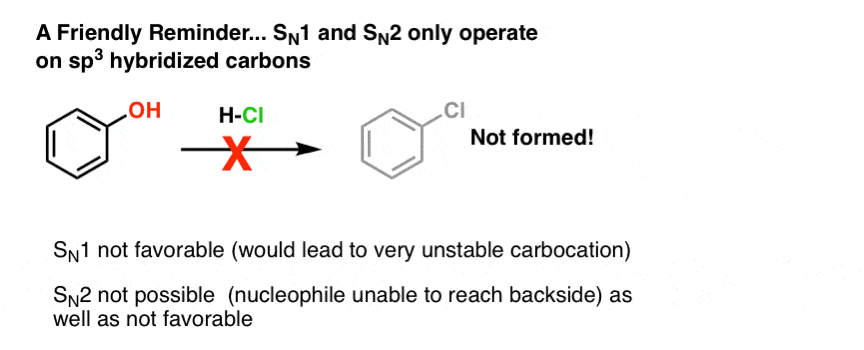
You might also wonder if we can use reagents like HCN, HOAc, or HN3 to convert alcohols to nitriles, esters, and azides respectively. Generally, no. The problem is that each of these are fairly weak acids (pKa 4 and above) so these will only give a low concentration of the protonated alcohol. Since the reaction rate is proportional to concentration, formation of these products will be slow. [With azides, there are also potential complications with a different type of rearrangement, but as a curtiusy we’re not going to deal with that schmidt right now : – ) ]

For our purposes, conversion of alcohols to other substitution products using strong acid is limited to HCl, HBr, HI, and the special case of H+/ROH which gives symmetrical ethers. A good rule of thumb is that the conjugate acid of the nucleophile should have a pKa of 0 or less in order for the reaction to occur.
10. Summary: Making Alkyl Halides From Alcohols
So alcohols can be converted to alkyl halides. You might ask, “why should we care?”. The answer is that, as we said, converting an alcohol (which has a poor leaving group) into an alkyl halide (which has a great leaving group) now allows us to do all kinds of functional group interconversions that were not previously possible. The SN2 is a very useful and powerful reaction, for example. Once a primary alcohol has been converted to a primary alkyl halide, we can then treat it with all varieties of nucleophiles to make a multitude of functional groups.
However nice it is to be able to do this, though, it’s far from ideal. We have to use strong acid, which can often cause complications if we have acid-sensitive functional groups on our molecule. Furthermore, all those pesky rearrangements on secondary carbons are a hassle. They can screw with our stereochemistry and lead to undesired products. You might ask, “isn’t there some way to get around that?”.
Yes! We’ll talk about a very nice way around this dilemma in the next post!
Next Post – Tosylates And Mesylates
Notes
Related Articles
Quiz Yourself!

Become a MOC member to see the clickable quiz with answers on the back.

Become a MOC member to see the clickable quiz with answers on the back.
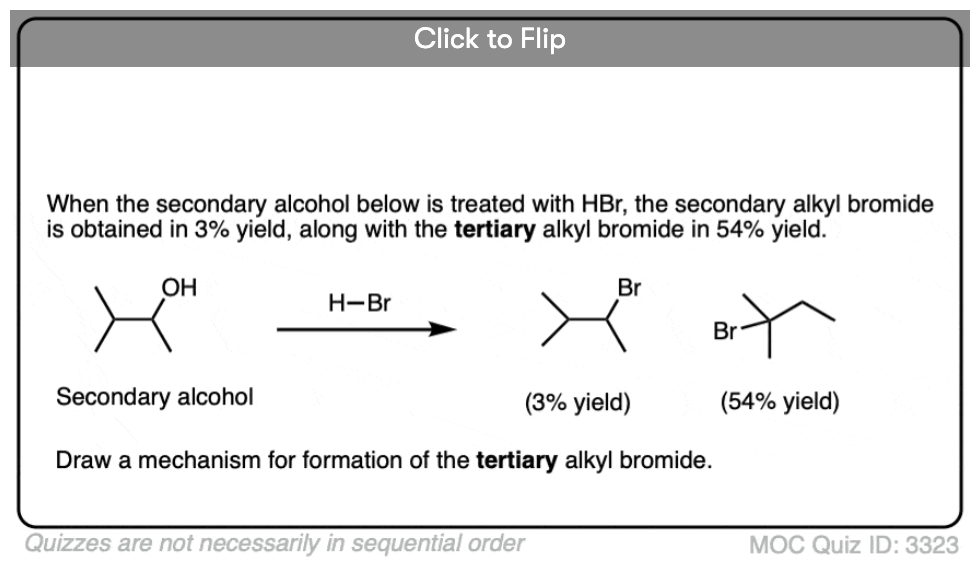
Become a MOC member to see the clickable quiz with answers on the back.
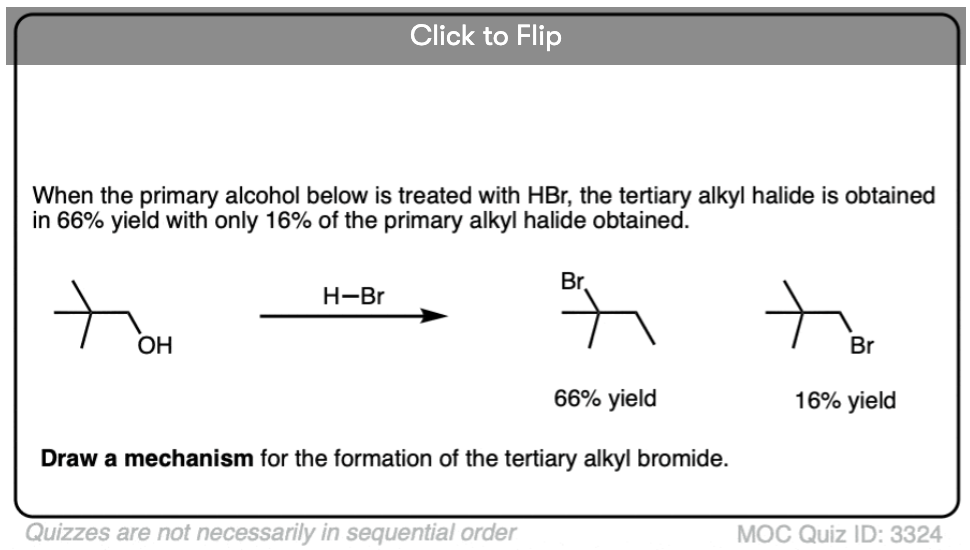
Become a MOC member to see the clickable quiz with answers on the back.
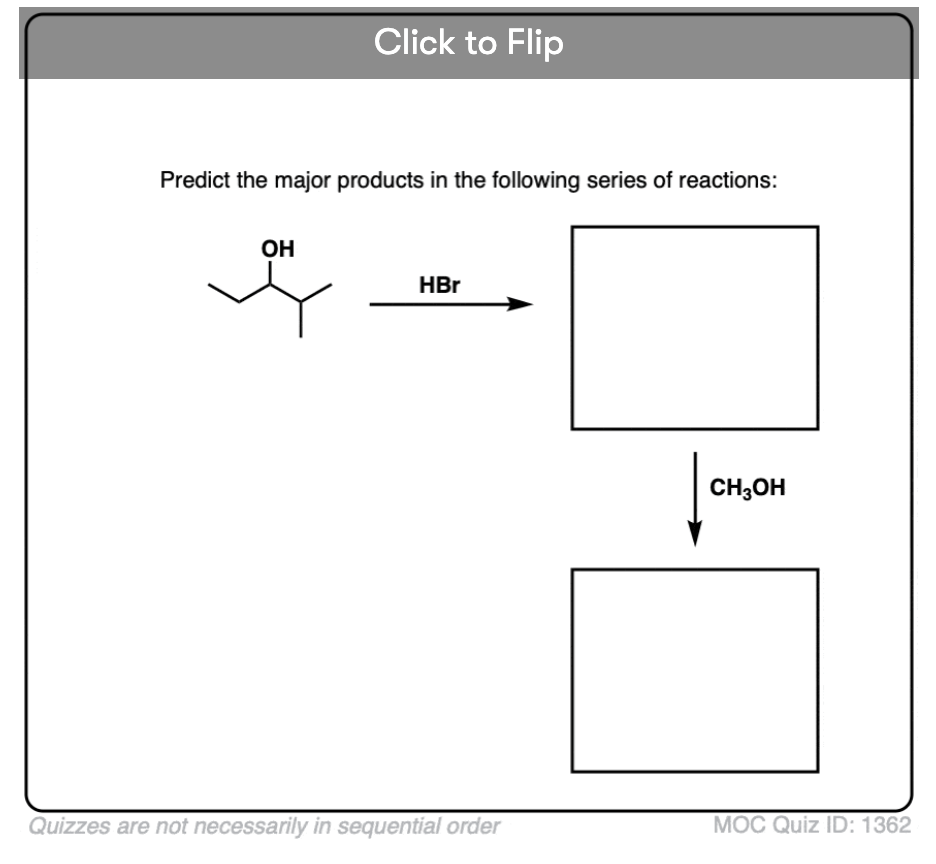
Become a MOC member to see the clickable quiz with answers on the back.
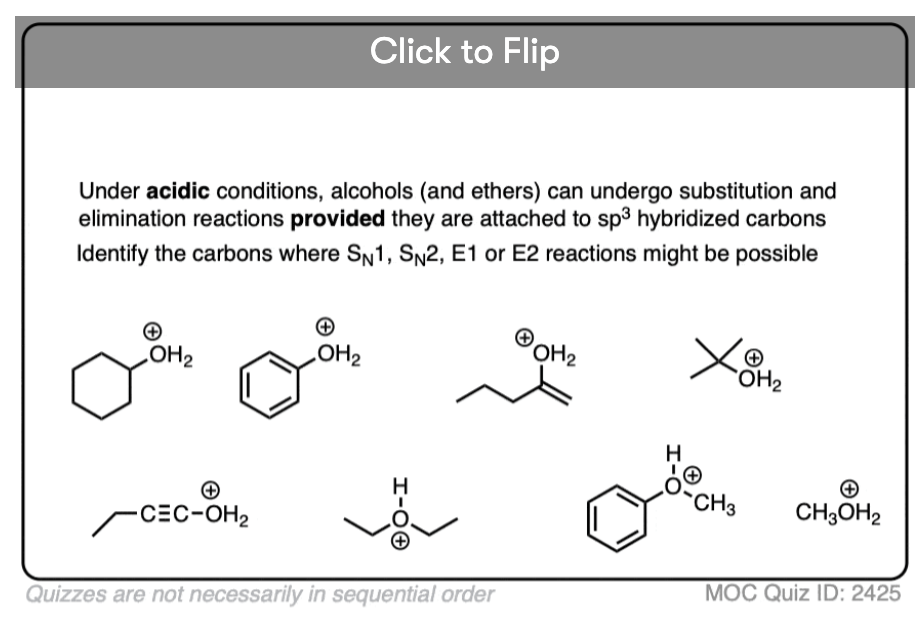
Become a MOC member to see the clickable quiz with answers on the back.
(Advanced) References and Further Reading
Alkyl chlorides from alcohols:
- -BUTYL CHLORIDE
James F. Norris and Alanson W. Olmsted
Organic Syntheses, Coll. Vol. 1, p.144 (1941); Vol. 8, p.50 (1928).
DOI: 10.15227/orgsyn.008.0050
An example of an SN1 conversion of tert-butanol to t-butyl chloride with HCl. This is from Organic Syntheses, a source of reliable and independently tested organic chemistry experimental procedures.Alkyl iodides from alcohols: - Reaction between unsaturated alcohols and potassium iodide in the presence of polyphosphoric acid
Richard Jones and J. B. Pattison
J. Chem. Soc. 1969, 1046
DOI: 10.1039/J39690001046
This paper uses KI + phosphoric acid to generate HI in situ, which converts alcohols to iodides. - 1,6-DIIODOHEXANE
Herman Stone and Harold Shechter
Synth. 1951, 31, 31
DOI: 10.15227/orgsyn.031.0031
A procedure from Organic Syntheses, a source of reliable and independently tested synthetic organic experimental procedures, for converting alcohols to iodides with KI + PPA (polyphosphoric acid). - Synthetic methods and reactions. 63. Pyridinium poly(hydrogen fluoride) (30% pyridine-70% hydrogen fluoride): a convenient reagent for organic fluorination reactions
George A. Olah, John T. Welch, Yashwant D. Vankar, Mosatomo Nojima, Istvan Kerekes, and Judith A. Olah
The Journal of Organic Chemistry 1979, 44 (22), 3872-3881
DOI: 1021/jo01336a027
Pyridinium poly(hydrogen fluoride), also known as PPHF or “Olah’s reagent” can be used as a Bronsted acid for converting alcohols to iodides, along with KI or NaI. - A Simple, Efficient, and General Method for the Conversion of Alcohols into Alkyl Iodides by a CeCl37H2O/NaI System in Acetonitrile
Milena Di Deo, Enrico Marcantoni, Elisabetta Torregiani, Giuseppe Bartoli, Maria Cristina Bellucci, Marcella Bosco, and Letizia Sambri
The Journal of Organic Chemistry 2000, 65 (9), 2830-2833
DOI: 10.1021/jo991894c
Lewis acids can be used for this reaction instead of a Bronsted acid, allowing for milder reaction conditions. - Direct conversion of alcohols into the corresponding iodides
Reni Joseph, Pradeep S. Pallan, A. Sudalai, T. Ravindranathan
Tetrahedron Lett. 1995 36 (4), 609-612
DOI: 10.1016/0040-4039(94)02315-3
Elemental iodine (I2) can also be used for directly converting alcohols to iodides.Alcohols can be converted to alkyl bromides with PBr3: - Convenient synthesis of labile optically active secondary alkyl bromides from chiral alcohols
Robert O. Hutchins, Divakar. Masilamani, and Cynthia A. Maryanoff
The Journal of Organic Chemistry 1976, 41 (6), 1071-1073
DOI: 1021/jo00868a034 - Synthesis of Optically Active Alkyl Halides
Harry R. Hudson
Synthesis 1969, 112-119
DOI: 1055/s-1969-34195
The main utility of PBr3 is that it allows the conversion of chiral alcohols to bromides with inversion of configuration without rearrangement, as the above two papers demonstrate. They also illustrate the mechanism of the reaction, going through the intermediate alkyl phosphites. - TETRAHYDROFURFURYL BROMIDE
L. H. Smith
Org. Synth. 1943, 23, 88
DOI: 10.15227/orgsyn.023.0088
This procedure from Organic Synthesis, a source of reliable and independently tested experimental organic chemistry procedures, shows how PBr3 is compatible with ethers.
00 General Chemistry Review
01 Bonding, Structure, and Resonance
- How Do We Know Methane (CH4) Is Tetrahedral?
- Hybrid Orbitals and Hybridization
- How To Determine Hybridization: A Shortcut
- Orbital Hybridization And Bond Strengths
- Sigma bonds come in six varieties: Pi bonds come in one
- A Key Skill: How to Calculate Formal Charge
- The Four Intermolecular Forces and How They Affect Boiling Points
- 3 Trends That Affect Boiling Points
- How To Use Electronegativity To Determine Electron Density (and why NOT to trust formal charge)
- Introduction to Resonance
- How To Use Curved Arrows To Interchange Resonance Forms
- Evaluating Resonance Forms (1) - The Rule of Least Charges
- How To Find The Best Resonance Structure By Applying Electronegativity
- Evaluating Resonance Structures With Negative Charges
- Evaluating Resonance Structures With Positive Charge
- Exploring Resonance: Pi-Donation
- Exploring Resonance: Pi-acceptors
- In Summary: Evaluating Resonance Structures
- Drawing Resonance Structures: 3 Common Mistakes To Avoid
- How to apply electronegativity and resonance to understand reactivity
- Bond Hybridization Practice
- Structure and Bonding Practice Quizzes
- Resonance Structures Practice
02 Acid Base Reactions
- Introduction to Acid-Base Reactions
- Acid Base Reactions In Organic Chemistry
- The Stronger The Acid, The Weaker The Conjugate Base
- Walkthrough of Acid-Base Reactions (3) - Acidity Trends
- Five Key Factors That Influence Acidity
- Acid-Base Reactions: Introducing Ka and pKa
- How to Use a pKa Table
- The pKa Table Is Your Friend
- A Handy Rule of Thumb for Acid-Base Reactions
- Acid Base Reactions Are Fast
- pKa Values Span 60 Orders Of Magnitude
- How Protonation and Deprotonation Affect Reactivity
- Acid Base Practice Problems
03 Alkanes and Nomenclature
- Meet the (Most Important) Functional Groups
- Condensed Formulas: Deciphering What the Brackets Mean
- Hidden Hydrogens, Hidden Lone Pairs, Hidden Counterions
- Don't Be Futyl, Learn The Butyls
- Primary, Secondary, Tertiary, Quaternary In Organic Chemistry
- Branching, and Its Affect On Melting and Boiling Points
- The Many, Many Ways of Drawing Butane
- Wedge And Dash Convention For Tetrahedral Carbon
- Common Mistakes in Organic Chemistry: Pentavalent Carbon
- Table of Functional Group Priorities for Nomenclature
- Summary Sheet - Alkane Nomenclature
- Organic Chemistry IUPAC Nomenclature Demystified With A Simple Puzzle Piece Approach
- Boiling Point Quizzes
- Organic Chemistry Nomenclature Quizzes
04 Conformations and Cycloalkanes
- Staggered vs Eclipsed Conformations of Ethane
- Conformational Isomers of Propane
- Newman Projection of Butane (and Gauche Conformation)
- Introduction to Cycloalkanes
- Geometric Isomers In Small Rings: Cis And Trans Cycloalkanes
- Calculation of Ring Strain In Cycloalkanes
- Cycloalkanes - Ring Strain In Cyclopropane And Cyclobutane
- Cyclohexane Conformations
- Cyclohexane Chair Conformation: An Aerial Tour
- How To Draw The Cyclohexane Chair Conformation
- The Cyclohexane Chair Flip
- The Cyclohexane Chair Flip - Energy Diagram
- Substituted Cyclohexanes - Axial vs Equatorial
- Ranking The Bulkiness Of Substituents On Cyclohexanes: "A-Values"
- Cyclohexane Chair Conformation Stability: Which One Is Lower Energy?
- Fused Rings - Cis-Decalin and Trans-Decalin
- Naming Bicyclic Compounds - Fused, Bridged, and Spiro
- Bredt's Rule (And Summary of Cycloalkanes)
- Newman Projection Practice
- Cycloalkanes Practice Problems
05 A Primer On Organic Reactions
- The Most Important Question To Ask When Learning a New Reaction
- Curved Arrows (for reactions)
- Nucleophiles and Electrophiles
- The Three Classes of Nucleophiles
- Nucleophilicity vs. Basicity
- What Makes A Good Nucleophile?
- What Makes A Good Leaving Group?
- 3 Factors That Stabilize Carbocations
- Equilibrium and Energy Relationships
- 7 Factors that stabilize negative charge in organic chemistry
- 7 Factors That Stabilize Positive Charge in Organic Chemistry
- What's a Transition State?
- Hammond's Postulate
- Learning Organic Chemistry Reactions: A Checklist (PDF)
- Introduction to Oxidative Cleavage Reactions
06 Free Radical Reactions
- Free Radical Reactions
- 3 Factors That Stabilize Free Radicals
- Bond Strengths And Radical Stability
- Free Radical Initiation: Why Is "Light" Or "Heat" Required?
- Initiation, Propagation, Termination
- Monochlorination Products Of Propane, Pentane, And Other Alkanes
- Selectivity In Free Radical Reactions
- Selectivity in Free Radical Reactions: Bromination vs. Chlorination
- Halogenation At Tiffany's
- Allylic Bromination
- Bonus Topic: Allylic Rearrangements
- In Summary: Free Radicals
- Synthesis (2) - Reactions of Alkanes
- Free Radicals Practice Quizzes
07 Stereochemistry and Chirality
- Types of Isomers: Constitutional Isomers, Stereoisomers, Enantiomers, and Diastereomers
- How To Draw The Enantiomer Of A Chiral Molecule
- How To Draw A Bond Rotation
- Introduction to Assigning (R) and (S): The Cahn-Ingold-Prelog Rules
- Assigning Cahn-Ingold-Prelog (CIP) Priorities (2) - The Method of Dots
- Enantiomers vs Diastereomers vs The Same? Two Methods For Solving Problems
- Assigning R/S To Newman Projections (And Converting Newman To Line Diagrams)
- How To Determine R and S Configurations On A Fischer Projection
- The Meso Trap
- Optical Rotation, Optical Activity, and Specific Rotation
- Optical Purity and Enantiomeric Excess
- What's a Racemic Mixture?
- Chiral Allenes And Chiral Axes
- Stereochemistry Practice Problems and Quizzes
08 Substitution Reactions
- Nucleophilic Substitution Reactions - Introduction
- Two Types of Nucleophilic Substitution Reactions
- The SN2 Mechanism
- Why the SN2 Reaction Is Powerful
- The SN1 Mechanism
- The Conjugate Acid Is A Better Leaving Group
- Comparing the SN1 and SN2 Reactions
- Polar Protic? Polar Aprotic? Nonpolar? All About Solvents
- Steric Hindrance is Like a Fat Goalie
- Common Blind Spot: Intramolecular Reactions
- Substitution Practice - SN1
- Substitution Practice - SN2
09 Elimination Reactions
- Elimination Reactions (1): Introduction And The Key Pattern
- Elimination Reactions (2): The Zaitsev Rule
- Elimination Reactions Are Favored By Heat
- Two Elimination Reaction Patterns
- The E1 Reaction
- The E2 Mechanism
- E1 vs E2: Comparing the E1 and E2 Reactions
- Antiperiplanar Relationships: The E2 Reaction and Cyclohexane Rings
- Bulky Bases in Elimination Reactions
- Comparing the E1 vs SN1 Reactions
- Elimination (E1) Reactions With Rearrangements
- E1cB - Elimination (Unimolecular) Conjugate Base
- Elimination (E1) Practice Problems And Solutions
- Elimination (E2) Practice Problems and Solutions
10 Rearrangements
11 SN1/SN2/E1/E2 Decision
- Identifying Where Substitution and Elimination Reactions Happen
- Deciding SN1/SN2/E1/E2 (1) - The Substrate
- Deciding SN1/SN2/E1/E2 (2) - The Nucleophile/Base
- SN1 vs E1 and SN2 vs E2 : The Temperature
- Deciding SN1/SN2/E1/E2 - The Solvent
- Wrapup: The Key Factors For Determining SN1/SN2/E1/E2
- Alkyl Halide Reaction Map And Summary
- SN1 SN2 E1 E2 Practice Problems
12 Alkene Reactions
- E and Z Notation For Alkenes (+ Cis/Trans)
- Alkene Stability
- Alkene Addition Reactions: "Regioselectivity" and "Stereoselectivity" (Syn/Anti)
- Stereoselective and Stereospecific Reactions
- Hydrohalogenation of Alkenes and Markovnikov's Rule
- Hydration of Alkenes With Aqueous Acid
- Rearrangements in Alkene Addition Reactions
- Halogenation of Alkenes and Halohydrin Formation
- Oxymercuration Demercuration of Alkenes
- Hydroboration Oxidation of Alkenes
- m-CPBA (meta-chloroperoxybenzoic acid)
- OsO4 (Osmium Tetroxide) for Dihydroxylation of Alkenes
- Palladium on Carbon (Pd/C) for Catalytic Hydrogenation of Alkenes
- Cyclopropanation of Alkenes
- A Fourth Alkene Addition Pattern - Free Radical Addition
- Alkene Reactions: Ozonolysis
- Summary: Three Key Families Of Alkene Reaction Mechanisms
- Synthesis (4) - Alkene Reaction Map, Including Alkyl Halide Reactions
- Alkene Reactions Practice Problems
13 Alkyne Reactions
- Acetylides from Alkynes, And Substitution Reactions of Acetylides
- Partial Reduction of Alkynes With Lindlar's Catalyst
- Partial Reduction of Alkynes With Na/NH3 To Obtain Trans Alkenes
- Alkyne Hydroboration With "R2BH"
- Hydration and Oxymercuration of Alkynes
- Hydrohalogenation of Alkynes
- Alkyne Halogenation: Bromination and Chlorination of Alkynes
- Oxidation of Alkynes With O3 and KMnO4
- Alkenes To Alkynes Via Halogenation And Elimination Reactions
- Alkynes Are A Blank Canvas
- Synthesis (5) - Reactions of Alkynes
- Alkyne Reactions Practice Problems With Answers
14 Alcohols, Epoxides and Ethers
- Alcohols - Nomenclature and Properties
- Alcohols Can Act As Acids Or Bases (And Why It Matters)
- Alcohols - Acidity and Basicity
- The Williamson Ether Synthesis
- Ethers From Alkenes, Tertiary Alkyl Halides and Alkoxymercuration
- Alcohols To Ethers via Acid Catalysis
- Cleavage Of Ethers With Acid
- Epoxides - The Outlier Of The Ether Family
- Opening of Epoxides With Acid
- Epoxide Ring Opening With Base
- Making Alkyl Halides From Alcohols
- Tosylates And Mesylates
- PBr3 and SOCl2
- Elimination Reactions of Alcohols
- Elimination of Alcohols To Alkenes With POCl3
- Alcohol Oxidation: "Strong" and "Weak" Oxidants
- Demystifying The Mechanisms of Alcohol Oxidations
- Protecting Groups For Alcohols
- Thiols And Thioethers
- Calculating the oxidation state of a carbon
- Oxidation and Reduction in Organic Chemistry
- Oxidation Ladders
- SOCl2 Mechanism For Alcohols To Alkyl Halides: SN2 versus SNi
- Alcohol Reactions Roadmap (PDF)
- Alcohol Reaction Practice Problems
- Epoxide Reaction Quizzes
- Oxidation and Reduction Practice Quizzes
15 Organometallics
- What's An Organometallic?
- Formation of Grignard and Organolithium Reagents
- Organometallics Are Strong Bases
- Reactions of Grignard Reagents
- Protecting Groups In Grignard Reactions
- Synthesis Problems Involving Grignard Reagents
- Grignard Reactions And Synthesis (2)
- Organocuprates (Gilman Reagents): How They're Made
- Gilman Reagents (Organocuprates): What They're Used For
- The Heck, Suzuki, and Olefin Metathesis Reactions (And Why They Don't Belong In Most Introductory Organic Chemistry Courses)
- Reaction Map: Reactions of Organometallics
- Grignard Practice Problems
16 Spectroscopy
- Degrees of Unsaturation (or IHD, Index of Hydrogen Deficiency)
- Conjugation And Color (+ How Bleach Works)
- Introduction To UV-Vis Spectroscopy
- UV-Vis Spectroscopy: Absorbance of Carbonyls
- UV-Vis Spectroscopy: Practice Questions
- Bond Vibrations, Infrared Spectroscopy, and the "Ball and Spring" Model
- Infrared Spectroscopy: A Quick Primer On Interpreting Spectra
- IR Spectroscopy: 4 Practice Problems
- 1H NMR: How Many Signals?
- Homotopic, Enantiotopic, Diastereotopic
- Diastereotopic Protons in 1H NMR Spectroscopy: Examples
- 13-C NMR - How Many Signals
- Liquid Gold: Pheromones In Doe Urine
- Natural Product Isolation (1) - Extraction
- Natural Product Isolation (2) - Purification Techniques, An Overview
- Structure Determination Case Study: Deer Tarsal Gland Pheromone
17 Dienes and MO Theory
- What To Expect In Organic Chemistry 2
- Are these molecules conjugated?
- Conjugation And Resonance In Organic Chemistry
- Bonding And Antibonding Pi Orbitals
- Molecular Orbitals of The Allyl Cation, Allyl Radical, and Allyl Anion
- Pi Molecular Orbitals of Butadiene
- Reactions of Dienes: 1,2 and 1,4 Addition
- Thermodynamic and Kinetic Products
- More On 1,2 and 1,4 Additions To Dienes
- s-cis and s-trans
- The Diels-Alder Reaction
- Cyclic Dienes and Dienophiles in the Diels-Alder Reaction
- Stereochemistry of the Diels-Alder Reaction
- Exo vs Endo Products In The Diels Alder: How To Tell Them Apart
- HOMO and LUMO In the Diels Alder Reaction
- Why Are Endo vs Exo Products Favored in the Diels-Alder Reaction?
- Diels-Alder Reaction: Kinetic and Thermodynamic Control
- The Retro Diels-Alder Reaction
- The Intramolecular Diels Alder Reaction
- Regiochemistry In The Diels-Alder Reaction
- The Cope and Claisen Rearrangements
- Electrocyclic Reactions
- Electrocyclic Ring Opening And Closure (2) - Six (or Eight) Pi Electrons
- Diels Alder Practice Problems
- Molecular Orbital Theory Practice
18 Aromaticity
- Introduction To Aromaticity
- Rules For Aromaticity
- Huckel's Rule: What Does 4n+2 Mean?
- Aromatic, Non-Aromatic, or Antiaromatic? Some Practice Problems
- Antiaromatic Compounds and Antiaromaticity
- The Pi Molecular Orbitals of Benzene
- The Pi Molecular Orbitals of Cyclobutadiene
- Frost Circles
- Aromaticity Practice Quizzes
19 Reactions of Aromatic Molecules
- Electrophilic Aromatic Substitution: Introduction
- Activating and Deactivating Groups In Electrophilic Aromatic Substitution
- Electrophilic Aromatic Substitution - The Mechanism
- Ortho-, Para- and Meta- Directors in Electrophilic Aromatic Substitution
- Understanding Ortho, Para, and Meta Directors
- Why are halogens ortho- para- directors?
- Disubstituted Benzenes: The Strongest Electron-Donor "Wins"
- Electrophilic Aromatic Substitutions (1) - Halogenation of Benzene
- Electrophilic Aromatic Substitutions (2) - Nitration and Sulfonation
- EAS Reactions (3) - Friedel-Crafts Acylation and Friedel-Crafts Alkylation
- Intramolecular Friedel-Crafts Reactions
- Nucleophilic Aromatic Substitution (NAS)
- Nucleophilic Aromatic Substitution (2) - The Benzyne Mechanism
- Reactions on the "Benzylic" Carbon: Bromination And Oxidation
- The Wolff-Kishner, Clemmensen, And Other Carbonyl Reductions
- More Reactions on the Aromatic Sidechain: Reduction of Nitro Groups and the Baeyer Villiger
- Aromatic Synthesis (1) - "Order Of Operations"
- Synthesis of Benzene Derivatives (2) - Polarity Reversal
- Aromatic Synthesis (3) - Sulfonyl Blocking Groups
- Birch Reduction
- Synthesis (7): Reaction Map of Benzene and Related Aromatic Compounds
- Aromatic Reactions and Synthesis Practice
- Electrophilic Aromatic Substitution Practice Problems
20 Aldehydes and Ketones
- What's The Alpha Carbon In Carbonyl Compounds?
- Nucleophilic Addition To Carbonyls
- Aldehydes and Ketones: 14 Reactions With The Same Mechanism
- Sodium Borohydride (NaBH4) Reduction of Aldehydes and Ketones
- Grignard Reagents For Addition To Aldehydes and Ketones
- Wittig Reaction
- Hydrates, Hemiacetals, and Acetals
- Imines - Properties, Formation, Reactions, and Mechanisms
- All About Enamines
- Breaking Down Carbonyl Reaction Mechanisms: Reactions of Anionic Nucleophiles (Part 2)
- Aldehydes Ketones Reaction Practice
21 Carboxylic Acid Derivatives
- Nucleophilic Acyl Substitution (With Negatively Charged Nucleophiles)
- Addition-Elimination Mechanisms With Neutral Nucleophiles (Including Acid Catalysis)
- Basic Hydrolysis of Esters - Saponification
- Transesterification
- Proton Transfer
- Fischer Esterification - Carboxylic Acid to Ester Under Acidic Conditions
- Lithium Aluminum Hydride (LiAlH4) For Reduction of Carboxylic Acid Derivatives
- LiAlH[Ot-Bu]3 For The Reduction of Acid Halides To Aldehydes
- Di-isobutyl Aluminum Hydride (DIBAL) For The Partial Reduction of Esters and Nitriles
- Amide Hydrolysis
- Thionyl Chloride (SOCl2) And Conversion of Carboxylic Acids to Acid Halides
- Diazomethane (CH2N2)
- Carbonyl Chemistry: Learn Six Mechanisms For the Price Of One
- Making Music With Mechanisms (PADPED)
- Carboxylic Acid Derivatives Practice Questions
22 Enols and Enolates
- Keto-Enol Tautomerism
- Enolates - Formation, Stability, and Simple Reactions
- Kinetic Versus Thermodynamic Enolates
- Aldol Addition and Condensation Reactions
- Reactions of Enols - Acid-Catalyzed Aldol, Halogenation, and Mannich Reactions
- Claisen Condensation and Dieckmann Condensation
- Decarboxylation
- The Malonic Ester and Acetoacetic Ester Synthesis
- The Michael Addition Reaction and Conjugate Addition
- The Robinson Annulation
- Haloform Reaction
- The Hell–Volhard–Zelinsky Reaction
- Enols and Enolates Practice Quizzes
23 Amines
- The Amide Functional Group: Properties, Synthesis, and Nomenclature
- Basicity of Amines And pKaH
- 5 Key Basicity Trends of Amines
- The Mesomeric Effect And Aromatic Amines
- Nucleophilicity of Amines
- Alkylation of Amines (Sucks!)
- Reductive Amination
- The Gabriel Synthesis
- Some Reactions of Azides
- The Hofmann Elimination
- The Hofmann and Curtius Rearrangements
- The Cope Elimination
- Protecting Groups for Amines - Carbamates
- The Strecker Synthesis of Amino Acids
- Introduction to Peptide Synthesis
- Reactions of Diazonium Salts: Sandmeyer and Related Reactions
- Amine Practice Questions
24 Carbohydrates
- D and L Notation For Sugars
- Pyranoses and Furanoses: Ring-Chain Tautomerism In Sugars
- What is Mutarotation?
- Reducing Sugars
- The Big Damn Post Of Carbohydrate-Related Chemistry Definitions
- The Haworth Projection
- Converting a Fischer Projection To A Haworth (And Vice Versa)
- Reactions of Sugars: Glycosylation and Protection
- The Ruff Degradation and Kiliani-Fischer Synthesis
- Isoelectric Points of Amino Acids (and How To Calculate Them)
- Carbohydrates Practice
- Amino Acid Quizzes
25 Fun and Miscellaneous
- A Gallery of Some Interesting Molecules From Nature
- Screw Organic Chemistry, I'm Just Going To Write About Cats
- On Cats, Part 1: Conformations and Configurations
- On Cats, Part 2: Cat Line Diagrams
- On Cats, Part 4: Enantiocats
- On Cats, Part 6: Stereocenters
- Organic Chemistry Is Shit
- The Organic Chemistry Behind "The Pill"
- Maybe they should call them, "Formal Wins" ?
- Why Do Organic Chemists Use Kilocalories?
- The Principle of Least Effort
- Organic Chemistry GIFS - Resonance Forms
- Reproducibility In Organic Chemistry
- What Holds The Nucleus Together?
- How Reactions Are Like Music
- Organic Chemistry and the New MCAT
26 Organic Chemistry Tips and Tricks
- Common Mistakes: Formal Charges Can Mislead
- Partial Charges Give Clues About Electron Flow
- Draw The Ugly Version First
- Organic Chemistry Study Tips: Learn the Trends
- The 8 Types of Arrows In Organic Chemistry, Explained
- Top 10 Skills To Master Before An Organic Chemistry 2 Final
- Common Mistakes with Carbonyls: Carboxylic Acids... Are Acids!
- Planning Organic Synthesis With "Reaction Maps"
- Alkene Addition Pattern #1: The "Carbocation Pathway"
- Alkene Addition Pattern #2: The "Three-Membered Ring" Pathway
- Alkene Addition Pattern #3: The "Concerted" Pathway
- Number Your Carbons!
- The 4 Major Classes of Reactions in Org 1
- How (and why) electrons flow
- Grossman's Rule
- Three Exam Tips
- A 3-Step Method For Thinking Through Synthesis Problems
- Putting It Together
- Putting Diels-Alder Products in Perspective
- The Ups and Downs of Cyclohexanes
- The Most Annoying Exceptions in Org 1 (Part 1)
- The Most Annoying Exceptions in Org 1 (Part 2)
- The Marriage May Be Bad, But the Divorce Still Costs Money
- 9 Nomenclature Conventions To Know
- Nucleophile attacks Electrophile
27 Case Studies of Successful O-Chem Students
- Success Stories: How Corina Got The The "Hard" Professor - And Got An A+ Anyway
- How Helena Aced Organic Chemistry
- From a "Drop" To B+ in Org 2 – How A Hard Working Student Turned It Around
- How Serge Aced Organic Chemistry
- Success Stories: How Zach Aced Organic Chemistry 1
- Success Stories: How Kari Went From C– to B+
- How Esther Bounced Back From a "C" To Get A's In Organic Chemistry 1 And 2
- How Tyrell Got The Highest Grade In Her Organic Chemistry Course
- This Is Why Students Use Flashcards
- Success Stories: How Stu Aced Organic Chemistry
- How John Pulled Up His Organic Chemistry Exam Grades
- Success Stories: How Nathan Aced Organic Chemistry (Without It Taking Over His Life)
- How Chris Aced Org 1 and Org 2
- Interview: How Jay Got an A+ In Organic Chemistry
- How to Do Well in Organic Chemistry: One Student's Advice
- "America's Top TA" Shares His Secrets For Teaching O-Chem
- "Organic Chemistry Is Like..." - A Few Metaphors
- How To Do Well In Organic Chemistry: Advice From A Tutor
- Guest post: "I went from being afraid of tests to actually looking forward to them".
According to the Quick N Dirty guide for Sub. and eli. , in case of 2 degree alcohol when we will treat it with HCL, we get a good leaving group(H2O) and a strong nucleophile(Cl-),so the major pathway should be SN2 but not SN1.How in this case we have to assume SN1?
Sir, may I ask why dry hydrogen halides are used as opposed to aqueous solutions of HX?
H2O will react with hydrogen halides to give H3O+ X-. The product will likely be the alcohol, not the halide.
Sir I have a small confusion. When we use lucas reagent ie ZnCl2 the oxygen of the alcohol coordinates to the zinc center which converts it into a good leaving group. But does using ZnCl2 + HCl in case of primary alcohols promotes Sn1? Cause I have seen a bunch of problems where they have asked to write the product when a primary alcohol is treated with lucas reagent but in all of them they have shown 1,2 shifts which can’t take place unless Sn1 is followed. But apparently as you said and I found in many other sources Sn2 should obviously be taking place.
You can think of the hydride as acting a bit like a nucleophile in an SN2 reaction where the hydride shift happens about the same time as breakage of the C-O bond. That’s probably the best way to look at it.
I am confused how reaction of lucas reagent with primary alcohol with one branching at the beta carbon proceeds (say ch3ch2ch(ch3)ch2oh ). Does it follow Sn1 or Sn2
Hi. In the Lucas reagent synthesis of methyl chloride fr. MeOH + HCl + ZnCl2… Does the excess water in HCl lead to the formation of dimethyl zinc chloride or something else, at all? The answer is two complex for my pea brain, haha
It wouldn’t be dimethyl zinc, since the methyl group in dimethyl zinc is similar in basicity to that of a Grignard reagent (and will be destroyed by water just as easily). Zinc does form strong bonds with oxygen, however…
Why is this resaction considered an nucleophilic substitution and not an electrophilic substitution?
In a substitution reaction, a bond breaks and forms on the same carbon. The reactant which contains that carbon is called the “substrate”.
In nucleophilic substitution, the substrate reacts with a nucleophile (e.g. an alcohol) and a new C-O bond forms and a C-X (carbon-halide) bond breaks.
There is also a reaction called electrophilic substitution. In electrophilic substitution, the substrate (e.g. benzene) reacts with an electrophile (e.g. Br+) resulting in formation of a C-Br bond and breaking of a C-H bond. Still substitution, but since the substrate is reacting with an electrophile, it’s called “electrophilic substitution”.
There is also such a thing as free radical substitution.
Hi,
How would reaction change if we have 2-bromo-1-propanol react with HBr ? instead of just propanol ?
Not the best example, since I’m not sure that’s a very stable compound (it easily snaps shut to form an epoxide) but eventually the alcohol would still be replaced with Br, to obtain 1,2-dibromopropane.
in Case 2 a) – the alkyl shif,
Is CH2 missing????
Yes fixed. Thanks!
Thank you so much for putting in a lot of efforts and bringing masterpieces to us. Your notes have always helped me and makes Organic Chemistry super fun and interesting as well.
Thanks Sheetal. Glad you find the site useful.
sorry, figure in section (Case 2 a) has an error
Yes, fixed. Thanks for catching it.
I wanna ask why we use nucleophilic substitution in the formation of alkyl halide rather then electrophilic?
The advantage is that substitution is more predictable. You know that the carbon-nucleophile bond will form on the carbon bearing the leaving group. In contrast, when performing electrophilic addition on an alkene, regioselectivity can be a problem. The major product will be determined by Markovnikov’s rule, and even then the selectivity can be bad (4:1). What if you want the anti-Markovnikov product? Or what if you have an alkene where both ends are equally substituted? These problems don’t arise with substitution.
When observing the reaction of butan-2-ol with HCl to produce 2-chlorobutane and water, what can we expect to see? Or will there be no observable reaction? And is it true that when tertiary alcohols react with HCl, the substance becomes more turbid yet with primary alcohols, the substance remains colourless/less turbid than secondary or tertiary reactions? Or does that only pertain to the Lucas Reagent?
Anhydrous Zncl2 is used in the preparation of alkyl chloride from alcohol and conc. HCL. Why?
It’s a good Lewis acid, coordinates to oxygen and assists with oxygen acting as a leaving group.
Conc. HI is not preferred in the preparation of an alkyl halide from an alcohol. Why?
It *will* work on paper, but in the lab, concentrated HI (48%) is nobody’s idea of a fun reagent to work with. There are many other ways. Use them.
Hi, I believe you have an error on the alkyl shift photo. Going from the second to last step to the final you lose a methyl group and in its place is a hi-lighted blue.
Yes, fixed. Thanks!
Is it necessary to use ZnCl2 in the reaction of HCl and Alcohols for preparing Alkyl Halides or can we simply react Alcohols with HCl for preparing Alkyl Halides? Why?
You’re talking about the Lucas test. Conversion of an alcohol to an alkyl halide does not strictly require ZnCl2, although that does speed up the reaction.
I think I’ve spotted a typo. In case 2a), the last structure should have a blue Methyl group rather than a blue H.
Thanks for a great page!!
Yes. Fixed. Thanks!
Possible to do ring expansion on cyclobutane to cyclohexane? Is there a point where a methyl shift is preferred over ring expansion, such as when rings become very large?
Not possible to go from cyclobutane to cyclohexane directly, since the carbocation would have to be adjacent to the 4 membered ring and it always involves a 1,2 shift.
When ring strain is not an issue (carbocations on 5, 6, 7 membered rings) then you can have mixtures of alkyl shift and ring expanded/contracted products.
For making alkyl halide from alcohol, HX is used. This HX is dry and made by reacting NaX with H2SO4 or in case of HI with H3PO4. So why NaX is not used directly to convert alcohol to alkyl halide?
Because OH- is a terrible leaving group compared to its conjugate acid (H2O).
PKa value of HCl is less than for H3O+. So, Cl- remains a weaker base than water. You mentioned in one of the older articles on Sn2 that a weaker base cant displace a stronger base. How can primary alcohols then react with HCl via an Sn2??
Good question.
The “weaker base can’t displace a stronger base” applies, as a rule of thumb, when the difference in pKa is about 8 or greater. When the difference is less, there will be some equilibrium between the two acids, however minor.
As it turns out, chloride ion is actually superior nucleophile to water, reacting with alkyl halides at faster rates. Practically, there will be water as a byproduct of a substitution reaction which might lead to some minor reversibility. This can be removed by adding an excess equivalent of HCl, which will protonate H2O to give H30+ (which of course is a much poorer nucleophile).
Hey James! When is the next article coming out?
I was wondering how to make a anti-Markovnikov halide from an anti-Markovnikov alcohol. Thanks for your help!
Well, this is precisely one situation where you’d want to perform nucleophilic substitution of an alcohol versus formation of the alkyl halide via addition of HX to the alkene.
Great article! Which software do you use for making molecule structures?
ChemDraw. Most educational institutions have a site licence